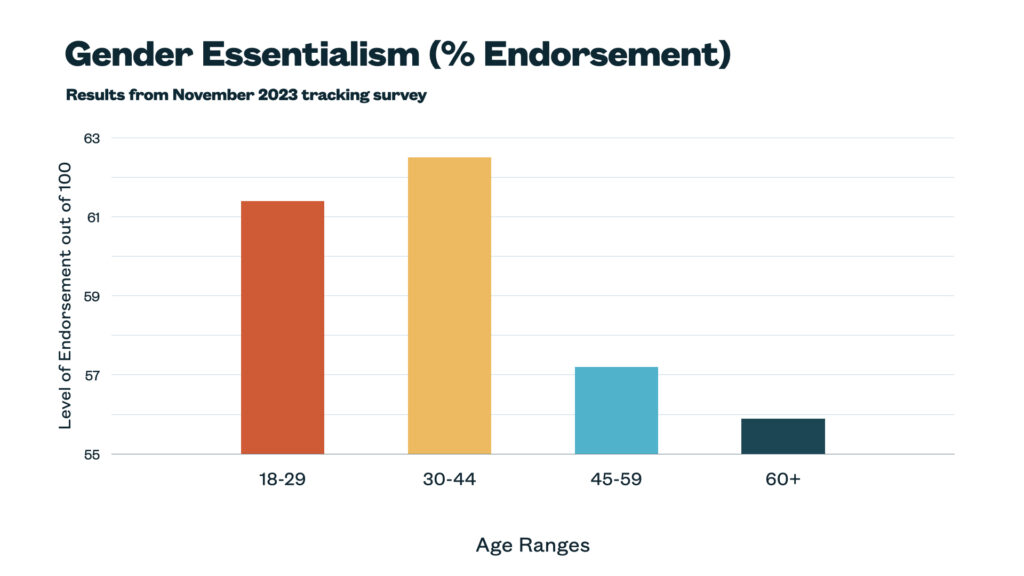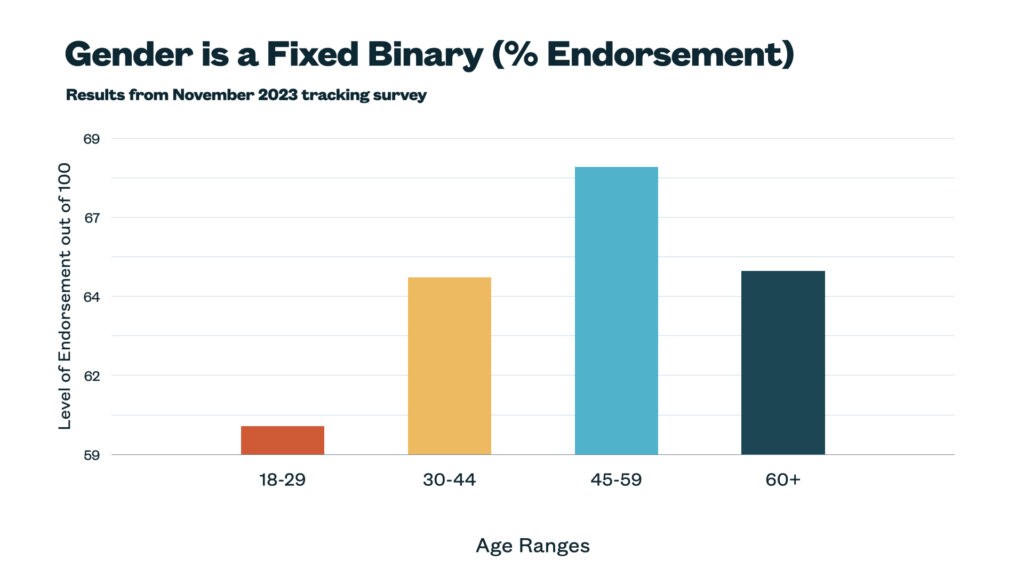
On Culture / Aug 21, 2024
3 Things to Know about How Americans are Thinking about Gender in 2024

In summer 2023, we shared some things to know about how Americans were thinking about gender. We now have a lot more data—including hugely revealing and somewhat surprising demographic information—that should inform our work as progressive communicators.
As we go through this, we’ll be focusing on three core mindsets that structure Americans’ thinking about gender:
- Gender is a fixed binary: the assumption that everyone’s gender is either “man” or ”woman,” and that gender is assigned at birth and remains unchanged throughout a person’s life.
- Gender essentialism: the idea that biological sex determines character and behavior.
- Gender is constructed: the idea that differences between genders are the result of what society expects.
Finding #1: While younger people are less likely than older people to believe that gender is a fixed binary, they are more likely to endorse gender essentialism.
Younger people are less likely than older people to believe that gender is a fixed binary.
However, younger people are more likely than older people to endorse gender essentialism. This means that younger people are more likely to think that our biological sex determines our personalities and behavior—believing, for example, that women are “naturally more caring” and men “naturally more aggressive.”

Gen-Z and Millennial participants have consistently endorsed gender essentialism at higher rates than their Gen-X and Baby Boomer counterparts over the last year of tracking—even as the youngest participants had the lowest levels of endorsement when it came to the gender is a fixed binary mindset:

The decline in strength of the gender is a fixed binary mindset with age is consistent with what we would have expected—younger people showing a more fluid understanding of gender. The fact that younger people are endorsing gender essentialism at higher rates is, however, more surprising. We aren’t sure yet why this is happening. We hypothesize that one factor is the rise of the tradwife phenomenon on social media—content aimed at promoting (and romanticizing) traditional gender roles amongst young people. Lived experience might also play a role—younger people were more likely than older people to have grown up with both parents working, but might still have experienced women doing a majority of the care work, perhaps reinforcing the idea that women are “naturally” more caring than men.
What this means: We’ll be digging into this more in the future, but for now it’s important for communicators not to take their younger audiences for granted. We often assume that because younger people hold more progressive views on some issues, this must be true across the board—but that’s not always the case.
Finding #2: Across party lines, Americans are using transphobic language as shorthand to refer to what is wrong with the world today.
Last summer, we wrote about how the manufactured moral panic positioning trans people as a threat to our country was linking any talk about “gender” with transgender issues and transphobia. That continues to be the case—any conversations about gender quickly turn to discussions fueled by the gender is a fixed binary mindset, with participants talking dismissively about the idea that someone might identify as being a gender different from the one assigned at birth.
This year, that pattern has only become more noticeable in focus groups—and we’re seeing it across party lines:
“Now, you can even identify yourself as an Apache helicopter because this world is going crazy. If I say I’m a cow, I wanna be a cow, I can identify as a cow. What is that? I don’t find that normal.”
—Research participant, Democrat
“There’s like 51 genders now… I know basic biology, and I thought only one gender could reproduce. But apparently I’m wrong. But science can’t be argued with, that’s all I’m saying.”
—Research participant, Republican
Note that participants have qualified their statements with language like ,“now…”, suggesting that in an older (“better”) time, everyone understood that there were only two fixed genders. When we hear talk that reflects the gender is a fixed binary mindset in focus groups, they are often either implicitly or explicitly comparing a present they are dissatisfied with to a past where things were more “normal.” That kind of talk comes not only from the gender is fixed binary mindset, but also from a mindset we call the threat of modernity mindset—the idea that life in this country used to be better and is getting worse. The threat of modernity mindset is often used in reactionary defense of the status quo.
What this means: deploying harmful and dehumanizing language against trans people to make the case that our country is going in the wrong direction. We’ll be exploring this connection more in upcoming research.
Finding #3: The idea that gender is a fixed binary is a hugely important, volatile site of contestation in American culture right now—and every progressive advocate has a stake in pushing against it.
Our research shows that the more strongly someone assumes that gender is a fixed binary, the more likely they are to:
- Oppose immigration policies such as support for asylum seekers and expanding legal pathways to citizenship;
- Oppose criminal legal reform such as the abolition of private prisons;
- Oppose government-provided childcare for all families;
- Oppose affirmative action, reparations made to Black Americans who are the descendants of enslaved people, and the teaching of US history with more emphasis on slavery and racism;
- Oppose making it easier for workers to join a union;
- Oppose a single-payer national health plan;
- Oppose a universal basic income.
More than almost any other mindset we study, the gender is a fixed binary mindset is linked to staunch support for upholding the status quo across issue areas. That makes sense, given its connections to the reactionary threat of modernity mindset. In other words, the idea that gender is a fixed binary lies at the heart of regressive thinking—it’s one of the lynchpins of reactionary thinking in the US. Any changes, whether they are made to humanize our immigration system, remodel our criminal legal system, expand government’s role in supporting children and families, address our country’s persistently racist legacy—are all threats to the status quo, and the more strongly people assume that gender is a fixed binary, the more committed they are to opposing progress of any kind.
What this means: There is already a highly coordinated effort to create a moral panic around trans issues, and the language of that panic has made its way into mainstream discourse. If we are to push back against this reactionary movement, we must make a highly coordinated effort as well, intentionally and strategically combatting the gender is a fixed binary mindset however we can.
Progressives now widely recognize that racism is bound up with all social issues, and that combatting it is necessary for transformative change across issues. This research indicates that, in a similar vein, gender should not be treated as a narrow issue. These reactionary understandings of gender must be recognized and combatted across social issues. Every issue we work on—and the lives of trans and gender-nonconforming people—are at stake.
Countries: United States